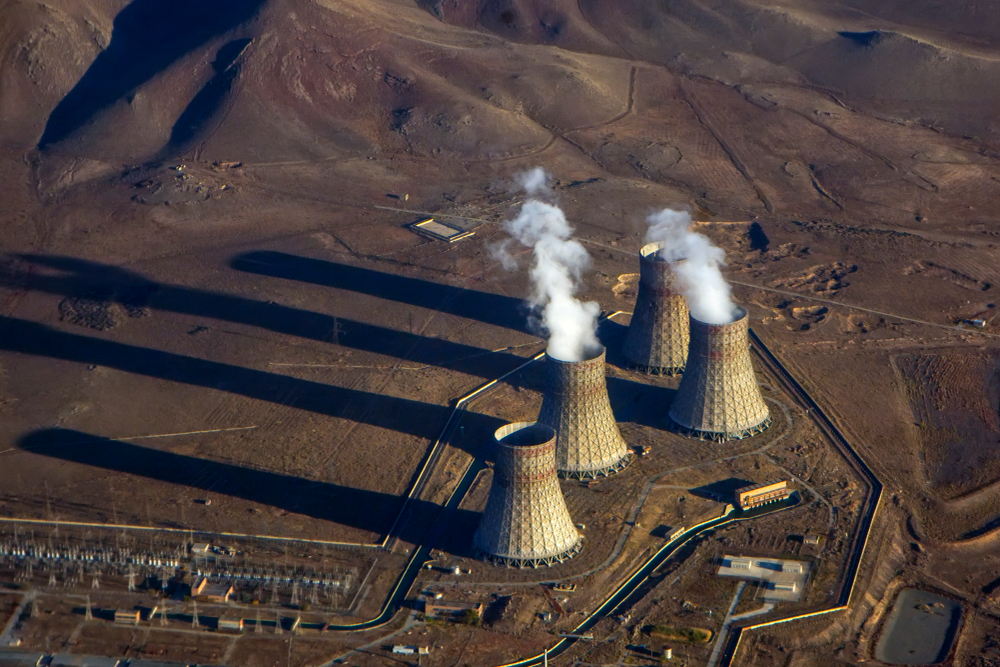
Metsamor Nuclear Power Plant, Armenia © Artem Avetisyan/Shutterstock
Armenia wants to close the Metsamor nuclear power plant, obsolete and built in seismic territory, and build a new plant by 2036. To achieve this, Yerevan is negotiating with Russia, France and the United States: a contest that touches on energy but also geopolitical issues
At the beginning of August, the Armenian government established a new body to oversee the long overdue replacement for the country’s ageing Soviet-era nuclear reactor by 2036. Yerevan is currently negotiating with several countries – in particular with Russia, United States, and South Korea – to construct a suitable replacement to meet future energy needs. The Metsamor nuclear power plant, which started operating in the late 1970s, is currently responsible for generating as much as 30–40 percent of the nation's power depending on seasonal fluctuations.
However, its safety has long been a concern due to its age, design, and location in a seismic zone. The European Union had previously called for its decommissioning in the 2000s, but – in the absence of alternatives – it has always remained operational, apart from six years following the devastating 1988 earthquake in the country.
The decision to replace it comes amid a global climate change concerns and a shift away from fossil fuels towards renewables as geopolitical competition in the region reaches unprecedented levels following the February 2022 invasion of Ukraine by Russia.
Nonetheless, in December 2023, Armenia signed a deal with Russia’s Rosatom to modernise and extend the reactor’s lifespan until 2036 to ensure that Metsamor remains operational until the new reactor is ready. The French nuclear reactor company Framatome also visited Armenia in August to meet with Armenian Security Council Secretary Armen Grigoryan who welcomed France’s additional interest in developing the Armenian atomic energy sphere.
It is believed, however, that Armenia favours the possibility of the United States constructing a new plant based on small modular reactors (SMR). Though scarcely tested for this purpose, SMRs are also seen as a way to help countries such as Armenia limit or reduce their reliance on Moscow for energy.
Earlier this year, Grigoryan stated that discussions with the U.S. regarding SMRs have entered a “substantive phase”, heightening the prospects of an energy partnership between Washington and Yerevan. Recently, the US State Department confirmed that it had received an application from Yerevan to expedite the process.
Key here is authorisation under the 1946 Atomic Energy Act to export civil nuclear technology abroad. In July, on her visit to Yerevan, U.S. Agency for International Development Administrator Samantha Power trumpeted Armenia's commitment to increasing its renewable energy resources, stating that nuclear energy would play a central role in this process.
In 2022, Armenia generated 9 gigawatt-hours (GWh) of electricity: only 21.8 percent came from hydropower, and 2.7 and 0.02 percent from solar and wind, compared to 43.5 percent from gas-driven thermal and 32 percent from nuclear power sources.
With Russia maintaining a monopoly on Armenia’s gas supply and distribution until 2043 under an agreement signed in 2013, nuclear is clearly considered key to reducing dependency on Moscow. In May 2022, U.S. Secretary of State Antony Blinken and Armenian Foreign Minister Ararat Mirzoyan signed a memorandum to explore the potential of SMRs. However, the U.S. has yet to build an operational SMR on its own soil after a similar project was abandoned last year due to costs estimated at approximately 5–9 billion dollars. Even so, commentators supporting Armenian Prime Minister Nikol Pashinyan say they believe the government favours such an option. Pashinyan has already called it “politically appealing.”
An Armenian delegation visited the U.S. last year to explore the potential of SMRs and the possibility of breaking free from Russia. Despite some experts, including those from the UN office in Yerevan, urge caution given that Russian technologies have already been tested and used in the country, Pashinyan continues to express interest in the American SMRs. In fact, it seems that Armenian Prime Minister has already made a decision and is only waiting for the legal conditions to be created to allow Armenia to receive US civil nuclear technology.
However, the issue of nuclear fuel remains. Currently it is transported to Armenia from Russia by air and it is unclear where it could be obtained from otherwise.
In an article written for Carnegie Endowment for International Peace by analyst Areg Kochinyan, one possibility is Kazakhstan. However, that presupposes that Russia would still allow transit through its airspace. Another alternative could be via Azerbaijan, but that looks unlikely even if Yerevan and Baku were to normalise relations.
The only remaining alternative, across the Caspian Sea and Iran, depends on whether the United States is ready to countenance such a move. In any case, a final decision on choosing a replacement for Metsamor is slated to be made during the next two years and will likely reflect the state of the competition between the West and Russia in the South Caucasus.
In the meantime, on 30 August, safety concerns were again raised after Metsamor was temporarily shut down following a lightning strike. The government stressed that it did so because the ageing nuclear plant’s automated safety systems functioned correctly. The following day it resumed operation.


































 To Top
To Top